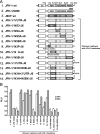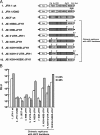The NS3 helicase and NS5B-to-3'X regions are important for efficient hepatitis C virus strain JFH-1 replication in Huh7 cells
- PMID: 17522229
- PMCID: PMC1951293
- DOI: 10.1128/JVI.02088-06
The NS3 helicase and NS5B-to-3'X regions are important for efficient hepatitis C virus strain JFH-1 replication in Huh7 cells
Abstract
The JFH-1 strain of hepatitis C virus (HCV) is a genotype 2a strain that can replicate autonomously in Huh7 cells. The J6 strain is also a genotype 2a strain, but its full genomic RNA does not replicate in Huh7 cells. However, chimeric J6/JFH-1 RNA that has J6 structural-protein-coding regions and JFH-1 nonstructural-protein-coding regions can replicate autonomously and produce infectious HCV particles. In order to determine the mechanisms underlying JFH-1 RNA replication, we constructed various J6/JFH-1 chimeras and tested their RNA replication and virus particle production abilities in Huh7 cells. Via subgenomic-RNA-replication assays, we found that both the JFH-1 NS5B-to-3'X (N5BX) and the NS3 helicase (N3H) regions are important for the replication of the J6CF replicon. We applied these results to full-length genomic RNA replication and analyzed replication using Northern blotting. We found that a chimeric J6 clone with JFH-1 N3H and N5BX could replicate autonomously but that a chimeric J6 clone with only JFH-1 N5BX had no replication ability. Finally, we tested the virus production abilities of these clones and found that a chimeric J6 clone with JFH-1 N3H and N5BX could produce infectious HCV particles. In conclusion, the JFH-1 NS3 helicase and NS5B-to-3'X regions are important for efficient replication and virus particle formation of HCV genotype 2a strains.
Figures





Similar articles
-
Production of infectious chimeric hepatitis C virus genotype 2b harboring minimal regions of JFH-1.J Virol. 2012 Feb;86(4):2143-52. doi: 10.1128/JVI.05386-11. Epub 2011 Dec 7. J Virol. 2012. PMID: 22156532 Free PMC article.
-
Amino Acid Mutations in the NS4A Region of Hepatitis C Virus Contribute to Viral Replication and Infectious Virus Production.J Virol. 2017 Jan 31;91(4):e02124-16. doi: 10.1128/JVI.02124-16. Print 2017 Feb 15. J Virol. 2017. PMID: 27928005 Free PMC article.
-
RNA polymerase activity and specific RNA structure are required for efficient HCV replication in cultured cells.PLoS Pathog. 2010 Apr 29;6(4):e1000885. doi: 10.1371/journal.ppat.1000885. PLoS Pathog. 2010. PMID: 20442786 Free PMC article.
-
Form confers function: Case of the 3'X region of the hepatitis C virus genome.World J Gastroenterol. 2018 Aug 14;24(30):3374-3383. doi: 10.3748/wjg.v24.i30.3374. World J Gastroenterol. 2018. PMID: 30122877 Free PMC article. Review.
-
[Production of infectious hepatitis C virus in cell culture].Uirusu. 2005 Dec;55(2):287-95. doi: 10.2222/jsv.55.287. Uirusu. 2005. PMID: 16557015 Review. Japanese.
Cited by
-
Production of infectious chimeric hepatitis C virus genotype 2b harboring minimal regions of JFH-1.J Virol. 2012 Feb;86(4):2143-52. doi: 10.1128/JVI.05386-11. Epub 2011 Dec 7. J Virol. 2012. PMID: 22156532 Free PMC article.
-
BK polyomavirus diversity-Why viral variation matters.Rev Med Virol. 2020 Jul;30(4):e2102. doi: 10.1002/rmv.2102. Epub 2020 Mar 3. Rev Med Virol. 2020. PMID: 32128960 Free PMC article. Review.
-
Hepatitis C virus cell culture models: an encomium on basic research paving the road to therapy development.Med Microbiol Immunol. 2019 Feb;208(1):3-24. doi: 10.1007/s00430-018-0566-x. Epub 2018 Oct 8. Med Microbiol Immunol. 2019. PMID: 30298360 Review.
-
Two crucial early steps in RNA synthesis by the hepatitis C virus polymerase involve a dual role of residue 405.J Virol. 2012 Jul;86(13):7107-17. doi: 10.1128/JVI.00459-12. Epub 2012 Apr 24. J Virol. 2012. PMID: 22532694 Free PMC article.
-
A Hepatitis C virus genotype 1b post-transplant isolate with high replication efficiency in cell culture and its adaptation to infectious virus production in vitro and in vivo.PLoS Pathog. 2022 Jun 28;18(6):e1010472. doi: 10.1371/journal.ppat.1010472. eCollection 2022 Jun. PLoS Pathog. 2022. PMID: 35763545 Free PMC article.
References
-
- Bartenschlager, R., and V. Lohmann. 2000. Replication of hepatitis C virus. J. Gen. Virol. 81:1631-1648. - PubMed
-
- Beard, M. R., G. Abell, M. Honda, A. Carroll, M. Gartland, B. Clarke, K. Suzuki, R. Lanford, D. V. Sangar, and S. M. Lemon. 1999. An infectious molecular clone of a Japanese genotype 1b hepatitis C virus. Hepatology 30:316-324. - PubMed
-
- Bukh, J., T. Pietschmann, V. Lohmann, N. Krieger, K. Faulk, R. E. Engle, S. Govindarajan, M. Shapiro, M. St. Claire, and R. Bartenschlager. 2002. Mutations that permit efficient replication of hepatitis C virus RNA in Huh-7 cells prevent productive replication in chimpanzees. Proc. Natl. Acad. Sci. USA 99:14416-14421. - PMC - PubMed
Publication types
MeSH terms
Substances
LinkOut - more resources
Full Text Sources
Other Literature Sources

